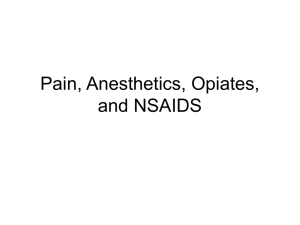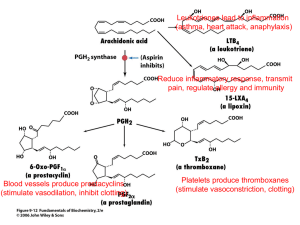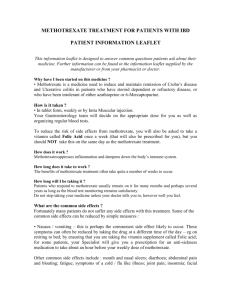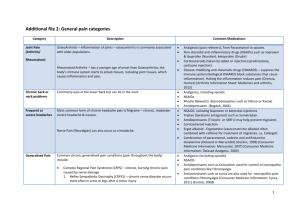Midterm review
advertisement
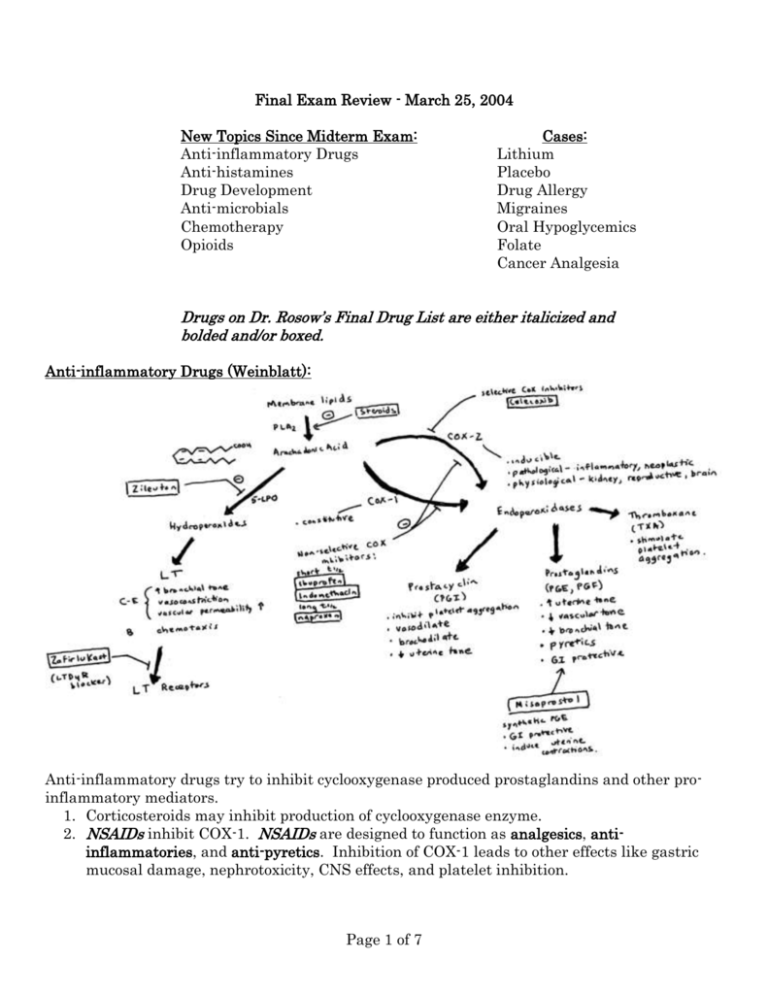
Final Exam Review - March 25, 2004
New Topics Since Midterm Exam:
Anti-inflammatory Drugs
Anti-histamines
Drug Development
Anti-microbials
Chemotherapy
Opioids
Cases:
Lithium
Placebo
Drug Allergy
Migraines
Oral Hypoglycemics
Folate
Cancer Analgesia
Drugs on Dr. Rosow’s Final Drug List are either italicized and
bolded and/or boxed.
Anti-inflammatory Drugs (Weinblatt):
Anti-inflammatory drugs try to inhibit cyclooxygenase produced prostaglandins and other proinflammatory mediators.
1. Corticosteroids may inhibit production of cyclooxygenase enzyme.
2. NSAIDs inhibit COX-1. NSAIDs are designed to function as analgesics, antiinflammatories, and anti-pyretics. Inhibition of COX-1 leads to other effects like gastric
mucosal damage, nephrotoxicity, CNS effects, and platelet inhibition.
Page 1 of 7
Aspirin irreversibly inhibits COX-1. Aspirin is used to inhibit thromboxane
synthase in platelets. Without thromboxane synthase, TXA2 levels decline, and the
patient’s ability to activate and aggregate platelets is diminished, so aspirin
functions as an anticoagulant (i.e. post MI or MI prophylaxis).
Other NSAIDs reversibly inhibit COX-1:
o
Ibuprofen, Indomethacin, Naproxen. Ibuprofen and Indomethacin have short
half lives vs. naproxen has a longer half life. This is important for rapid onset
or longer duration of action. Uses of these drugs include rheumatoid arthritis,
osteoarthritis, gouty arthritis, dysmenorrhea, surgical pain, and other
muscular pain.
o
Sulfasalazine a molecule of sulfapyridine linked to 5-aminosalicylic acid.
Sulfasalazine travels to intestine where it is broken down by bacteria,
releasing the anti-inflammatory 5-aminosalicylic acid. Sulfasalazine is used
in ulcerative colitis
NSAIDs cause gastropathic side effects by reducing levels of cytoprotective
prostaglandins like PGE1. Misoprostol is a PGE1 analog which restores the
cytoprotective effect to GI mucosa (mainly maintaining vascular tone and blood flow
which prevents epithelial damage and necrosis).
To avoid some of the side effects caused by COX-1 inhibition, there is a new class of
drugs called coxibs or COX-2 selective inhibitors. These drugs include celecoxib and
rofecoxib, which are used for rheumatoid arthritis, osteoarthritis, gouty arthritis,
dysmenorrhea, surgical pain, other muscular pain, and for familial adenomatous
polyposis (celecoxib). Theoretically the coxibs should decrease gastropathic side
effects. However, they may have deleterious cardiovascular effects.
3. Newer methods of anti-inflammatory therapy: anti-cytokine therapies which limit TNF
levels.
Etanercept: soluble TNF receptor. Used in rheumatoid arthritis as a monotherapy.
Infliximab: anti-TNF IgG. Used in Crohn’s disease, and in rheumatoid arthritis in
combination with methotrexate.
Newest anti-TNF is adaliumumab, also a monoclonal antibody.
Anti-Histamine Drugs (Dershwitz):
1. H1 blockers: diphenhydramine, chlorpheniramine, promethazine, terfenadine,
fexofenadine.
a. Used to control hypersensitivity reactions (antagonize bronchoconstriction,
vasodilatation, itch), lessen rhinorrhea and coughing, causing sedation (also a
general side effect).
b. Anti-cholinergic side effects: xerostomia, blurred vision, urinary retention,
tachycardia, mydriasis
c. Terfenadine can cause arrythmias. Terfenadine is a prodrug converted into
fexofenadine.
2. H2 blockers: cimetidine, ranitidine, famotidine
Page 2 of 7
a. Used for gastric ulcers, peptic ulcers, etc.
b. Cimetidine is a P450 inhibitor (inhibits liver metabolism of estrogen
hyperestrinism gynecomastia, spider angiomata (recall cirrhosis))
c. Instead of H2 blockers, can use proton pump inhibitors like omeprazole which have a
longer lasting effect (because they covalently inhibit the gastric H+ / K+ ATPase.
i. These of course are non-competitive inhibitors.
Drug Development
1. Pre-clinical research: Need to find great number of possible compounds which may have
some biological effect (natural products, combinatorial chemistry, rational drug design, etc.).
2. Pre-clinical screening: biochemical and research, screening, animal tests. File Notice of
Claimed Investigational Exemption for a New Drug (IND) with the FDA to begin human
trials. (Probably also have to go through IRBs as well. These are institution specific, i.e. not
under FDA regulation per se).
3. Human Clinical Trials:
Phase One: safety and pharmacokinetics
Phase Two: Efficacy and establish clinical doses
Phase Three: large multi-center trial, establish efficacy, find rare side effects
4. File New Drug Application (NDA) with FDA. FDA will consider evidence and approve.
5. Phase Four: Post-Marketing Surveillance. Monitor safety of drug as it is in use. Advantage
here is that now potentially millions of patients are taking drug, so evidence of very rare side
effects (say 0.1% and below) can be uncovered more easily than in Phase III.
Page 3 of 7
Anti-microbials (Rubin): You do not need to focus on principles of therapeutics (dosing, etc.), but
as always, you should know the major classes and their mechanism (this diagram).
Tuberculosis regimen: RIPES = rifampin, isoniazid, pyrazinamide, Ethambutol, Spectinomycin
Isoniazid: decrease synthesis of mycolic acids required for waxy cell wall of TB. Can
cause hemolysis in G6PD and neurotoxicity. Administer with vitamin B6 (prevent
neuropathy).
Page 4 of 7
Anti-neoplastics (Kufe):
Recognize how various anti-neoplastics act at every step of the way from nucleotide, to DNA
synthesis, transcription, translation, and cell cycle (with vinca alkaloids blocking M phase).
Principle of combination chemotherapy: for chemotherapy using multiple drugs with distinct
mechanisms, to achieve maximum effect subject to each drug’s dose limiting toxicity
o Compare to hypertension: use multiple drugs to minimize side effects and doses
Resistance to Cancer Drugs: compare and contrast to microbial resistance mechanisms
o Decreased expression of gene decrease uptake: Methotrexate, CytArabinoside
Page 5 of 7
o Increased expression of gene: resistance to methotrexate by increasing the copy
number of the DHFR gene. (double minute chromosomes, and HSR)
o Altered gene product: methotrexate, 5-FU, vinca alkaloids
Opioids (Rosow):
Mechanism: decrease adenylate cyclcase via Gi coupled receptors
Uses of opioids: analgesia. Also used for cough suppression (dextromethorphan), and as antidiarrheal agents (loperamide, diphenoxylate).
o Can combine opioids and analgesics: Oxycodone can be combined with
acetaminophen percocet
Side effects: respiratory depression (lose response to hypercapnia, hypoxia), pupillary
constriction, nausea and vomiting, smooth muscle constriction, dependence, constipation,
urinary retention.
o Meperidine: opioid agonist that causes less smooth muscle contraction, so could be
useful for analgesia in biliary colic (will not increase tone in sphincter of Oddi)
Dependence involves physical and psychological dimensions. Physical = withdrawal
(vomiting, diarrhea, mydriasis, chills); psychological = need for opioid induced euphoria
Tolerance: tolerance develops to all side effects except miosis and constipation.
Opioids can directly induce histamine release without activation of IgE. This is an
Anaphylactoid reaction, but not a true allergic reaction (review anaphylactic v. anaphylactoid)
Antagonists: naloxone, naltrexone
*Note the sigma receptor – a variant which was thought to explain hallucinogenic effect of some
drugs. Dr. Rosow talked of delta, mu and kappa which are the three major receptor classes.
Page 6 of 7
Other Cases and Topics:
Lithium: used to treat mania and manic depression and SIADH. Mechanism is blocking IP3
recycling / synthesis pathway. Side effects include diabetes inspidus = polydipsia and polyuria.
Drug Allergy: Both hydralazine and procainamide cause drug induced lupus. Recall
procainamide is acetylated, and the pharmacogenetic profile of slow vs. fast acetylators
Migraine:
Sumatriptan: Migraine may be related to cycle of meningeal vasodilatation (from numerous
factors, trauma, neurotoxicity, toxic amino acids, etc. which is exacerbated by possibly NO and
CGRP = calcitonin gene related peptide {see 2004 NEJM}); pain transduced along ophthalmic
division of CN V. Triptans are serotonin (5HT1B and 1D subtype specific) agonists. Effect is likely
due to vasoconstriction of specific meningeal vessels (5HT1B) and inhibiting neurotransmission
within trigeminal nuclei and from trigeminal nuclei to cortical pain center.
Ergotamine: stimulate smooth muscle and sympatholytic. May work in same mechanism as
triptans (5HT1B agonist).
Oral Hypoglycemics: Various mechanisms:
Metformin: type of biguanide that decreases serum glucose. Side effect: lactic acidosis
(possibly fatal).
Glyburide, tolbutamide: types of sulfonylurea. These agents increase K+ influx into islet cells
which stimulates insulin release and hypoglycemia. Older agents like glyburide have
disulfuram-like effects (recall so does metronidazole and some cephalosporins!).
Acarbose, miglitol: Types of alpha-glucosidase inhibitors which prevent breakdown and
uptake of glucose from intestines.
Rosiglitazone, Pioglitazone, etc.: type of thiazolidinedione activate PPAR signaling pathways
that increase peripheral sensitivity to insulin (recall that Lipoprotein Lipase inhibitors may
also increase PPAR activity!).
Folate: Major cofactor in one carbon metabolism. Molecular structure is combination of
pteroate, p-aminobenzoate, and poly glutamate groups. Involved in synthesis of purines, dTMP,
and methionine.
Antibiotics: humans do not synthesize folates, but microbes do. Two key enzymes are
dihydropteroate synthase and dihydrofolate reductase (same enzyme as methotrexate). These
two enzymes are inhibited by sulfamethoxazole and trimethoprim (combination is called
Bactrim).
Methotrexate inhibits DHFR. Inhibiting DHFR traps all folate in oxidized form. To prevent
deleterious effects on normal cells, give reduced form of folate called Leucovorin (= rescue).
Cancer Analgesia: various pain meds include opioids and supplement NSAIDs, tricyclics, etc.
Page 7 of 7



